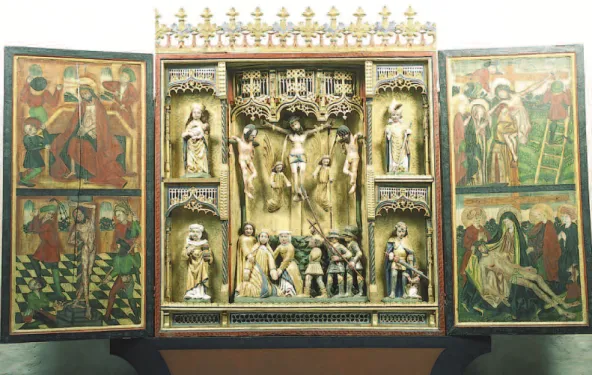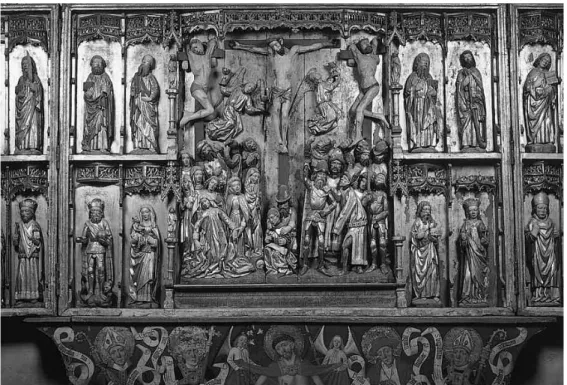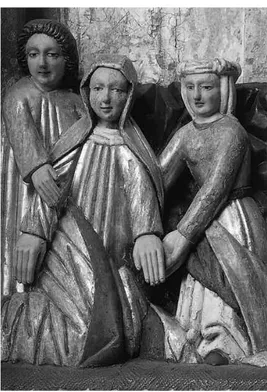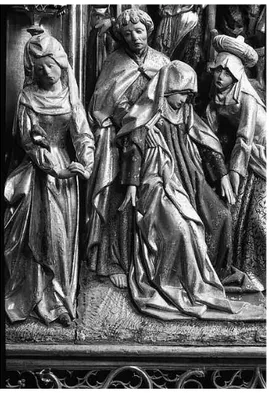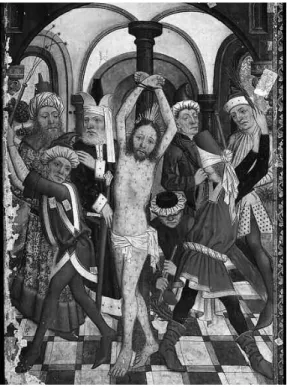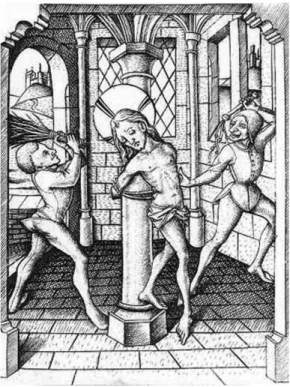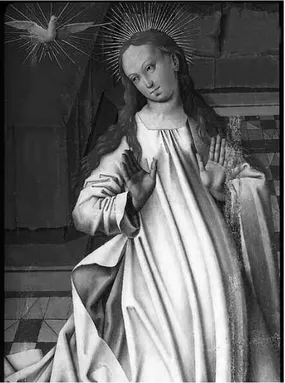German and Flemish in the Härad altarpiece : a provincial Swedish work
with far-reaching connections
Earl, Carol
Fornvännen 2008(103):2, s. [89]-101 : ill.
http://kulturarvsdata.se/raa/fornvannen/html/2008_089
Ingår i: samla.raa.se
Härad parish's little Romanesque church, situat-ed in a sparsely populatsituat-ed region in the Swsituat-edish province of Södermanland, houses an extraordi-nary accumulation of Medieval art. There are pieces sculpted in stone and wood, painted on panels or sculptures, and worked in copper and cloth. Just how these works of art were accumu-lated will perhaps rest a mystery, but the objects themselves reveal a wealth of information about the late Gothic period in Sweden. The impor-tance of the Härad altarpiece – a typical, locally produced work – is in its manifestation of the wi-dely varying influences upon Swedish artisans/ craftsmen and their adaptations. In examining these influences and their interpretation in the Härad altarpiece (fig. 1), I will demonstrate an
approach to stylistic analysis of local works of art such as the above.
The parish of Härad is located on the road between Strängnäs and Eskilstuna, an impor-tant route for pilgrims worshiping the Swedish Saint Eskil during the Middle Ages. The rich-ness of its art could indicate that it functioned as a stage on the pilgrimage. Many Swedish church archives were seized and destroyed around 1530, following the Reformation, including those of Härad. The foundation date of the church is therefore difficult to establish. An analysis of architectural style and details indicate a date of origin around 1200 (Redelius 1994, p. 3).
Some objects of art furnishing the church – like the baptismal font, the holy rood and a
reli-German and Flemish in the Härad
Altarpiece: a Provincial Swedish Work
with Far-reaching Connections
By Carol Earl
Earl, C., 2008. German and Flemish in the Härad altarpiece: a Provincial Swedish Work with Far-reaching Connections. Fornvännen 103. Stockholm.
The provincial altarpiece above the main altar in the parish church of Härad in Södermanland shows diverse influences upon its authors. A close examination of this Late Medieval Passion piece gives us opportunity to compare the impact of German and Flemish works of art in Sweden upon its craftsmen. This transitional altarpiece combines characteristics typical of both German and Flemish retables. Other influences such as the historical development of skilled workers in Sweden, the physical situation of the church in the proximity of Strängnäs Cathedral, its supposed patron saints and the involvement of the commissioner of the work are taken into consideration, as well as the artistic ability of the craftsmen themselves. Finally an analytical approach to provincial works is proposed using the parallel case of the Ljusdal and Oviken altarpieces.
Carol Earl, Drève de Linkebeek 8, BE-1640 Rhode-St-Genèse, Belgium
quary – date from the 13th century and were probably acquired at the end of its construction. The Passion altarpiece and two shrines (one to the Apocalyptic Madonna and the other to Mary Magdalen) come from the 15th century.
Considering the relative isolation of the Lake Mälaren area and its late development in a Eu-ropean perspective (Stockholm was not founded until 1251), sources of inspiration for Swedish artisans and artists were limited. These sources include imported works of art like paintings and altarpieces, books, illuminated manuscripts, stu-dio drawings, copperplates, block books etc. Books and illuminated manuscripts lost today are docu-mented in wills and archives (Hedlund 1993, pp. 26–36).
Many artists came from other parts of Eu-rope to decorate Swedish churches and castles, perhaps encouraging specialization among Swe-dish craftsmen. The lack of SweSwe-dish craftsmen is documented in Lindberg’s (1989, pp. 152–153) study of Medieval guilds. According to a contro-versial legend, painters among the local monks also contributed to the decoration of churches and monasteries (Bonsdorff 1990, p. 259–287). In fact, few monks are recorded as pictor (painter or sculptor): one in Vadstena monastery’s regis-ter and one assigned to Strängnäs Dominican monastery from Dortmund in 1502 (Reichert 1901, p. 77). Little indicates that Swedish artists traveled in Europe to learn their profession, since as late as 1546, king Gustav I complained about his subjects’ reluctance to learn special-ized crafts (Lindberg 1989, p. 152).
In this paper, I will examine two main strands of European artistic influence on the altarpiece from Härad, Flemish and German.
Flemish innovations in technique and com-position were adopted widely in European art in general from c. 1390. These reflected an interest in the realistic depiction of material and of our surroundings, in the expression of human pathos and in relating narratives anchored in everyday life. Their “illusion of reality” is a subject treated by Didier Martens (1998, pp. 255–277) and their concept of pictoral space by Roland Recht (2007, pp. 177–185) and Henri Pauwels (1998, pp. 243– 253).
German art and altarpieces could have been
imported to the Diocese of Strängnäs as early as 1251, the year the Hanseatic Union in Lübeck was invited to participate in the founding of Stockholm. However, Lübeck altarpieces influ-enced by Flemish art, incorporating narrative scenes, were probably not imported to Sweden until the mid-15th century (Andersson 1980, p. 69; Tångeberg 1986, p. 305). Aron Andersson (1980, p. 67) also noted the paucity of works imported to the diocese of Strängnäs before the first Flemish altarpiece in Sweden, which was ordered by Bishop Rogge during his investiture at Strängnäs Cathedral (1480–1501).
With this framework in mind we will now examine influences on the Härad altarpiece.
The altarpiece from Härad
The Härad altarpiece (fig. 1) is a triptych previ-ously dated between 1450 and 1500. The subject of the piece is the Passion of Christ, one of the most popular motifs during the Middle Ages. The caisse measures 149x149 cm and the wing dimensions are 74.9 by 148.9 cm. The general condition of the piece is very good: only one arm and some decorative tracery are missing. The piece has been restored several times, and the gilding and polychromy have obviously been retouched. The extant predella is not original.
The sculpted Crucifixion in the center com-partment of the caisse is surrounded by smaller niches containing statues of the Virgin with child, Mary Magdalen, Thomas Beckett and Saint Mar-tin. An architectural décor frames the compart-ments. The paintings on the wings depict scenes from the Passion. On the left wing, we find the Flagellation and the Crowning of Thorns. The right wing has the Descent from the Cross and the Pietà. Closed, the wings display an Annunci-ation with the angel Gabriel to the left of the Virgin.
The difference in quality between the Cruci-fixion scene and the individual statues surround-ing it is striksurround-ing and disturbs the unity of the piece. The figures of the Crucifixion are crudely sculpted, the faces poorly defined in contrast with the sculpted figures in the surrounding com-partments. A comparison of the two Mary Mag-dalen figures presented confirms that two (or more) sculptors have worked on the altarpiece.
The Magdalen in the compartment has a round, turned-up nose; her clothing is sophisticated with complicated draped folds, her turban and veil immaculate. The Swooning group Mag-dalen’s nose is big and straight, her dress folds are straight and her turban simple.
The individual statues are too small for the side compartments – an indication that they were “prefabricated” and not designed specifi-cally for this caisse.
The position of Mary Magdalen in the left lower compartment of the caisse (instead of the Virgin) must be pointed out as atypical for the iconography of this time. Usually changes in ico-nographic representation of this type indicate a particular interest in this saint on the part of the benefactor commissioning the work or the church in which it would repose, and their subsequent influence upon the artist’s representation. The additional presence of a separate altar to Mary Magdalen in Härad church demonstrates a spe-cific interest in this saint.
The caisse
A central Crucifixion scene surrounded by indi-vidual carved figures in separate compartments is typical of German altarpieces. It resembles that of an altarpiece originally in the Great Church of Stockholm, a Lübeck work, dated 1468 with paintings attributed to Herman Rode (fig. 2; Andersson 1980, pp. 109–110). This altarpiece later came to Österåker church and is now in the Museum of National Antiquities (SHM 3753). The number of side compartments in its caisse is two times those of Härad, but the organization is the same. Its interior wings are sculpted with the compartments containing more statues of individual saints, but the paintings on their exterior represent similar themes and colors as those found on the interior wings of Härad.
At first glance, the altarpiece from Österåker seems to be the prototype for the Härad altar-piece. It would certainly have been seen as an important work of art in Sweden at that time, originally hanging in the same cathedral that
contained Notke’s St. George sculpture. We can safely assume that the author of the Härad piece or the person commissioning it had seen it.
This organization of the caisse is rarely found in Flemish altarpieces, where the com-partments surrounding the central scene con-tain sculpted narrative scenes and the interior wings’ scenes are painted (Phillipot 1990, pp. 111–119; Jacobs 1998, pp. 239–244). Saints’ statu-es rarely appear on their wings. The only Flem-ish altarpiece in Sweden that approaches the Lübeck altarpiece from Österåker in composi-tion is that of Folkärna in Dalecarlia, dated around 1500.
The Crucifixion scene of the Härad altar-piece is typical for the Late Middle Ages. The altarpiece from Österåker has a similar presenta-tion with the exceppresenta-tion of the number of partici-pants at the foot of the cross. These erect figures surrounding the central scene are presented in stiff, fully frontal positions. Although the drap-ing of the robes of the Virgin and Mary Mag-dalen are individualized, their faces are from the
same mold, sweet, round and smiling. This “iconic” presentation is an important similarity between the two pieces.
However, upon looking closer, we find signi-ficant differences. In the Härad retable, Christ’s crown of thorns is plaited. The thieves are hang-ing from crosses, made not of planks, but of tree trunks. They are blindfolded and scantily clothed. Most striking is their long brown hair. Where do these details come from? A Flemish altar-piece, the Passion of Christ II, conserved in near-by Strängnäs Cathedral (fig. 3), displays these specific characteristics – and other similarities. Referred to as “Lilla Roggeskåpet” in Sweden, Strängnäs II (dated around 1500) was the sec-ond Flemish altarpiece commissioned by Bishop Rogge for the Cathedral (Andersson 1980, p. 187). The impression of depth created by the thieves’ crosses on a diagonal towards the interi-or of the compartment and the rocky ground ascending towards the background features in both altarpieces – a typically Flemish composi-tion (Phillipot 1990, p. 112). This, along with
Carol Earl
the treatment of the hair, the blindfolds and the tree-trunk crosses in both are also typically Flemish. The position of the thieves’ heads and feet correspond. In both, the angels’ wings are straight and open. The treatment of the angels’ robes resembles that of the painted wings of the first Flemish altarpiece in Strängnäs, Strängnäs I, dated to before 1493 (Périer-D’Ieteren 1985, p. 77).
The Swooning of the Virgin group at the foot of the cross merits close examination. The Härad and Österåker altarpieces have superficial similarities (figs 4–5): the rigidity of the figures, frozen in their sorrow, looking out of the altar-piece towards the spectator. In contrast, the Swoo-ning scene in the Strängnäs II altarpiece is full of movement and the reactions of one person to another’s sorrow (fig. 6). The weakness of the fainting Virgin is confirmed by the position of her legs traced under her heavy robe. Mary Mag-dalen bends towards the Virgin to take her hand and arm, her face filled with compassion. The same expression marks the face of St. John as he
supports the Virgin, turning away from the grue-some crucifixion. Is it possible to compare this sophisticated scene with the Härad altarpiece in all its simplicity? In my opinion, the author of the Härad altarpiece, with his limited talent, has attempted to reproduce the essential elements of the Strängnäs work in his Swooning group.
The internal relationship and differences in height of the figures in the Strängnäs II Swoon-ing (St. John very tall, the Virgin shorter and Mary Magdalen between the two) corresponds with that of the Härad scene. The figure of Mary Magdalen could safely be called a copy of her figure in Strängnäs II. Numerous details con-firm this proposition: the position of her body bent towards the Virgin, the way she takes the hand of the Virgin in hers with the other hand supporting her at the waist, her dress with its straight bodice where the skirt folds up to the waist at the same angle, her turban knotted in the same spots and her shoe peeking out from under the skirt. The figure of Mary Magdalen demonstrates clearly the correspondence be-tween the two pieces.
The location of St. John to the right of the Virgin, his hand visible on the Virgin's arm, cor-responds with the Strängnäs piece, as does his hair, shorter and straighter than in the Österåker altarpiece.
Finally the Virgin. The Härad Virgin does not give the impression of swooning, but the folds of her robe betray the influence of Strängnäs II. The Härad sculptor may not have been as tal-ented as his Flemish counterparts, but he tried to imitate them. In comparison, the fall of the folds in the Härad Virgin’s robe are different from those of the virgin in the Österåker altar-piece. They arrive from the back to bend around the Virgin’s bent leg, whence they cascade to-wards the floor. Her robe or veil lies over her shoulders as in Strängnäs II. The front of her dress displays similar straight parallel folds. At the neck of her dress, the white wimple recalls the one in Strängnäs II.
Even the group of three soldiers in the Härad crucifixion have some details of clothing that correspond with the two soldiers to the lower far right of the Strängnäs II crucifixion, i.e. the boots and armor.
Fig. 3. Detail of crucifixion, Strängnäs II. Photograph Lennart Karlsson.
A question of methodology: documentation was recently published of a local copy of a so-phisticated altarpiece, the altarpieces of Ljusdal and Oviken (Höglund 1999). If the letter com-missioning the copy of the Ljusdal altarpiece for the Oviken church had not been preserved, one would doubt that these two pieces were related. An initial comparison of the two works shows few similarities other than the choice of icono-graphy and the order of scenes. The difference in colors used reinforces the enormous difference in quality of the sculptures. Whereas blue and gold dominate the Antwerp altarpiece of Ljus-dal, the locally produced Oviken piece is pre-dominately green and red.
When trying to determine if a work of art is a copy or a forgery, we normally search for ele-ments that are out of place, i.e. clothing or ob-jects dating from a later period than that which the work purports to present. In working with primitive copies, the technique is the opposite. Since the skill of the provincial artist is usually
limited, his copy is not obvious. One is obliged to search among minor elements such as details, objects, clothing and composition (often exag-gerated) to confirm resemblances between the two works. An example in the Ljusdal-Oviken altarpieces is the scene of the Presentation at the temple, where details of the priest’s clothing (ro-sette and bag) reveal a direct connection between the two works. From this point of departure, one is encouraged to search for other similarities that are then more easily found. This technique app-lies to the Härad Swooning scene as previously demonstrated. The Ljusdal-Oviken example gives credence to this associative approach as a tech-nique in diagnosing influences on works of art.
The wings
The interior wings have four scenes from the Passion. On the right wing is the descent from the cross and a pietà scene. On the left the Crow-ning of thorns and the Flagellation. As regards the wing paintings, reference must first be made
Carol Earl
Fig. 4. Swooning group, Härad. Photograph Lennart Karlsson.
Fig. 5. Swooning group, Österåker. Photograph Lennart Karlsson.
totheir condition. This piece has been restored numerous times. The thick layers of paint in many places make it difficult to judge if what we see today is actually what was originally repre-sented. However, in general one can presume that the paintings do represent the originals because they present a uniform ensemble as regards their size, colors, size and number of figures and sub-ject matter. The paintings on the outside of the wings are severely damaged and it would be risky to draw any conclusions based upon them.
Notably different is the treatment of the eyes on the left and right wings. Superficially round-ed, hollowed-out eyes are used on the left wing, whereas on the right, they are lightly drawn with brief black lines or deeply set under pro-truding eyebrows.
A lack of perspective leaves a two-dimensio-nal flat effect despite an effort to create a sense of depth through the use of a diagonally tiled floor, windows in background walls and landscapes in the distance. The character of the paintings leads
me to believe that the painter may have been a mural specialist.
The origin of the wing paintings of the Hä-rad altarpiece could lie in illuminated manu-scripts. Nearer to hand, however, are the paint-ings of the altarpiece from Österåker that corre-spond on most points with the left wing. The same slender, elongated figures are found, not only in illuminated manuscripts, but also in the paintings of the Flemings Roger van der Wey-den and Dirk Bouts. Charles C. Cuttler (1998, p. 596) notes the influence of Bouts upon Her-man Rode’s Vision of the Virgin to Saint Luke (1485) in its space, warm colors and Eyckian clair-obscure – commenting on the otherwise archaic character of paintings from North of Germany of that time.
The left wing paintings
In the Flagellation scene (fig. 7) the torso of Christ is reminiscent of pre-Eyckian illuminated manuscripts. According to Hoogewerff (1936– 47), these illuminations were the source of in-spiration later on for the Master of Catherine of Clèves, Wm. Vrelant. Hoogewerff further con-tends that Vrelant in his turn influenced artists of the Baltic region, including Herman Rode to whom the Österåker altarpiece has been attri-buted (fig. 8; Hoogewerff 1936–47, vol. 1, p. 468). A copperplate from the small series of the Passion of Christ by Master E.S. (German, active 1440–1467) appears to have inspired the basic composition (fig. 9). However, the posi-tion of the arm of Christ over his head is repre-sented neither in the Österåker altarpiece nor in the E.S. copperplate. We do find it in the Litsle-na (Uppland) altarpiece, a Lübeck work from the period 1470–1500.
The positions of the tormentors could have been taken from a mural on the triumphal arch in Strängnäs cathedral dating around 1460. The bald dwarf holding the rope binding Christ to the pillar is an exact copy. This depiction in its turn seems to have been taken from a copper-plate by the Master of 1446, an anonymous Ger-man artist, date carved in woodblock. The bur-lesque touch of exposing a torturer's naked rump is also found in Master E.S.’s copperplate men-tioned above.
Fig. 6. Swooning group, Strängnäs II. Photograph Lennart Karlsson.
The influence of the Österåker altarpiece con-tinues in the scene with the crowning with thorns. It is evident in the face of Christ, the man knee-ling before him, the hat of the torturer to his right and the arched openings in the back-ground wall. The position of the legs and arms of the torturers of the two altarpieces corre-spond with those of another of Master E.S.’ Pas-sion series copperplates. Since the Härad depic-tion shows the kneeling torturer bald as in the copperplate and lifting his hat as in the Österåk-er painting, its paintÖsteråk-er theoretically could have been acquainted with both works and combined them – or had another source of inspiration.
The pleats in Christ’s robe have been care-fully treated to accentuate the heavy texture of the cloth and the creases formed upon its reach-ing the ground, perhaps an influence of the carved interpretation of this scene found in Strängnäs II. Certainly this treatment of materi-al originated in Flemish paintings with van Eyck. The open robe showing Christ’s bleeding
torso has no equivalent in either Rode's or E.S.’s works, but occurs in Strängnäs II. Provincial artists often chose to emphasize the pathetic or cruel aspects of these scenes, adding sores and blood to cover Christ’s body or dripping from the thorns on his crown. The Revelations of St. Bridget of Sweden (14th century) provided sur-prisingly detailed descriptions of Christ’s suffer-ings such as the number of strokes (five thou-sand) received during the flagellation and cer-tainly influenced the imagery of the time (Hall 1974, pp. 80, 123).
The right wing
This wing of the Härad altarpiece differs from the Österåker paintings in that it presents two new themes: The Descent from the Cross and the Pietà (fig. 10). The popularity of the Descent from the Cross in Sweden was probably due to the belief in the miraculous powers of a specific group that was a part of an altarpiece in the Do-minican Priory in Stockholm (Andersson 1960,
Carol Earl
Fig. 8. Flagellation, painted external wing, Österåker. Photograph Lennart Karlsson.
Fig. 7. Flagellation, left internal wing, Härad. Photograph Lennart Karlsson.
p. 150). Copies were executed by Swedish mas-ters like Håkan Gulleson (Njutånger, Hälsing-land) and Johannes Sculptor (Östra Ryd, Upp-land). It is then not surprising to find this par-ticular theme represented in Härad's altarpiece – in spite of it not being represented among the Österåker paintings.
The presentation of this theme differs from the paintings on the left wing in that the figures are massive, their bodies hidden under the hea-vy drapes of cloaks and clothing, the faces fuller. The grouping of St. John, the Virgin and Joseph holding Christ dominates the left foreground. The right side of the scene is filled with symbo-lic masses of green rocks or bushes ascending towards the background, perhaps an attempt to reproduce the background common in Flemish carved scenes.
The central figures of Joseph and Christ are treated in greater detail than the others in this scene. Joseph’s face, his eye sunken deep be-neath protruding eyebrows and his cheekbone
ascending to his temple is finely modeled. Christ’s face in death is fixed in an expression of suffer-ing, his eyebrows framing the deep, closed eyes. The Virgin and St. John, however, have generic oval faces with eyes briefly sketched, lacking the shadowed contours of the central figures. Their eyebrows are, however, severely compressed, ex-pressing their sorrow.
These briefly sketched eyes are similar to those painted by Jordan Målare (painter and sculptor active in Stockholm and Arboga, 1460– 80) on the Sollentuna altarpiece (Uppland). Jor-dan Målare and other Swedish artisans such as Albertus Pictor used copperplates as inspiration for their works (Kempff 1985, p. 29–33). The Tott altarpiece (Aspö, Södermanland) is an out-standing example of the use of copperplates from Master E.S.'s small passion series as the primary source of inspiration for a work by a provincial artisan (Earl 2004). One hypothesis might be that the prints studied by these pain-ters were ones reproduced in such numbers that the hatching of the eyes on the copperplate origi-nals had been reduced to only a few traces – traces which were faithfully copied by the painters.
However, the contrasting treatment of the eyes within the same composition corresponds with the treatment of the eyes and the morpho-logy in the wing paintings attributed to Colyn de Coter of Strängnäs I (Périer-D’Ieteren 1984). The Virgin’s smooth oval face with eyes modest-ly peering downward is found in the Nativity and the Annunciation scenes (fig. 11). Joseph’s knobby face could have been inspired by any number of figures, e.g. the Devil in the Tempta-tion of Christ or the kneeling king in the Adora-tion of the Magi. Joseph’s turban figures promi-nently on the standing king in that same scene. The softly rounded features and the bodies hid-den under robes falling in heavy folds is charac-teristic of the treatment on the Strängnäs I pan-els. The feet of Christ with long bent toes corre-spond with these panels. Finally, the use of small dots of a lighter hue against a darker rounded form to create the effect of bushes mounting in waves towards the horizon can also be found in the background of the Temptation scene of Strängnäs I.
The morphology of Christ’s feet is repeated
Fig. 9. Flagellation, Master E.S. Kupferstichkabinett, Staatliche Museen zu Berlin.
even in the scenes of the left panels in contrast to his feet having long flat toes in the Österåker panels. Another correspondence between the left panel and Strängnäs I is the voluminous robe enveloping Christ in the Crowning of Thorns. In the Österåker depiction, the robe is skimpy and short. Nicodemus and the other figure on the ladders releasing Christ from the cross are depict-ed with leggings of a different color for each leg. These leggings are not found in the Österåker panel, but are repeated on two figures in Härad's Flagellation scene. Without these corresponden-ces between the right and left panels, one would be tempted to propose that the left and right panels were painted by different painters – so contrasting they are in style and composition.
The Pietà also seems to be inspired by the paintings of Strängnäs I. We again find a green landscape in the background. The monumental group of mourners is clothed in voluminous draped robes with only faces and hands appa-rent. Their faces are smooth ovals with lightly
drawn eyes and small bow-shaped lips. Christ’s gory body lays across the inner lining of the Vir-gin’s robe – he bears only a loincloth and the crown of thorns. Dominating the scene are the folds of material in the robes. Worked in detail in its final broken cascade to the floor, the Virgin’s cloak seems to overflow the borders of the painting.
The Brussels altarpiece in By (Dalecarlia) pre-sents a scene corresponding to the position of the Virgin holding Christ (c. 1510). The Sträng-näs I altarpiece also presents us a carved image of this kind, a typical theme for Brussels altar-pieces (Nieuwdorp 1993, p. 142). Only the Vir-gin in Strängnäs I, however, resembles the Härad Virgin in the angle of the head, the way her robe is draped over her head, falling in heavy, broken pleats under the right arm of Christ to the green rocky ground.
In a mural (c. 1435) in Ärentuna church (Upp-land), the draping of the Virgin's veil and angle of her head are strongly reminiscent of the Hä-rad scene. These murals are attributed to the
Fig.11. Detail of Annunciation, Strängnäs I. Photograph Lennart Karlsson.
Fig. 10. Descent from the Cross, right internal wing, Härad. Photograph Carol Earl.
Mälar Valley School (ATA, Ikonografiskt regis-ter 1771:5, IP86) and are worthy of further exa-mination.
There is no exact counterpart of this scene among the works of Master E.S. The morpholo-gy and the angle of the Härad Virgin’s head mir-ror those of the Virgin in prayer of Master E.S., which in its turn seems to have been inspired by the painting “Christ and Maria” attributed to the Master of Flémalle (Bever 1987, p. 39). St. John’s long light hair shows a strong similarity to that of St. John in Master E.S.'s Crucifixion. It is unknown how many of his works survive – a third of the 320 known copperplates exist in only one example (Shestack 1967, p. 4).
The theme of the Pietà was widely spread in Sweden in Flemish, German and local altarpie-ces. It is impossible to point to any specific source of inspiration other than the stylistic influence of the nearby Strängnäs altarpieces.
Conclusion
The Härad altarpiece displays a mixture of many influences. German ones can be seen in the sha-pe of the caisse and its compartments which cor-respond to the format of the Lübeck altarpieces. It shows great likeness to the altarpiece from Österåker previously in Stockholm (1468), even though the number of small side compartments bordering the central scene is reduced to half. The statues of saints surrounding the central Calvary scene reinforce the impression of corre-spondence between the two pieces. The stubby, round figures of the individual statues are more typical of German art than Flemish. The iconic stances of all the carved figures reflect those of Österåker. The left interior wing paintings take their themes and style from the Österåker piece. The right interior wing paintings present the same color scheme and marry well with the whole. The engraved gold background of the caisse is typical of German altarpieces.
The Flemish influences on Härad can be seen in the use of a carved wood caisse with painted interior wings. Its architectonic décor is more extravagant than in the Österåker piece and typical for Flemish altarpieces. The open-work friezes at the base of the caisse correspond with Flemish friezes.
The author of the Härad altarpiece has di-rectly incorporated elements from Strängnäs II, a Brussels altarpiece, in the sculptures of the cor-pus. The long dark hair of the thieves, and their clothes, the crosses made of tree trunks, the pointed, straight wings of the angels demon-strate an intimate knowledge of the Strängnäs piece. The thieves' crosses, diagonally placed, and the rocks in the interior of the scene lending a sense of depth are also present in both works. In the Swooning scene, the relationship of the participants to each other and the details of their clothing are (evidence for a) direct influence of Strängnäs II. St. John is positioned behind the Virgin in the Österåker piece and Strängnäs I, whereas in Strängnäs II and Härad he is to her right.
Further, we find in the paintings of the wings, particularly in the right wing, a stylistic influ-ence from the wing paintings of Strängnäs I. Strängnäs Cathedral with its wealth of decora-tion, its murals and altarpieces, has given the author of Härad access to works of art and inspi-ration not readily available in rural Sweden. This evidence for the influence of cathedral art upon objects found in nearby churches comple-ments the findings of Carina Jacobsson (1995, p. 273) regarding wooden sculptures in the diocese of Linköping.
Finally, the church or benefactor commis-sioning the work has probably influenced the iconography and perhaps even the style by indi-cating particularly admired works of art. Not only the placement of Mary Madelene, but also the choice of the Pietà and the Descent from the Cross for the right wing – and their stylistic interpretation – indicate a strong individual pre-sence.
In summary, we see the influence upon the Härad altarpiece of a) foreign works of art in Sweden, such as Lübeckian and Flemish altar-pieces; b) local works like the murals in Sträng-näs Cathedral; c) copperplate prints; d) the per-sonal preferences of the church or person com-missioning the work; e) the artisans interpreta-tion – all combined in one small provincial altar-piece.
The dating of the Härad altarpiece will obvi-ously have to be amended to a date after the
arrival of Strängnäs II in Sweden around 1500, making a realistic date the first quarter of the 16th century.
References
Andersson, A., 1980. Medieval Wooden Sculpture in
Swe-den, vol. III. Late Medieval Sculpture. Stockholm. von Bonsdorff, J. & Kempff, M., 1990. Vadstena
Klos-ter – ett medeltida konstcentrum? I Heliga Birgittas
trakter. Uppsala.
Cuttler, C., 1998. Le Rayonnement des Primitifs Fla-mands. de Patoul, B. & R. van Schoute (eds). Les
Primitifs Flamands et leur temps. Tournai.
Earl, C., 2005, Le retable Tott et ses sources. Annales
d’Histoire de l’Art & d’Archéologie 26. Brussels.
– 2006. Mysteriet kring altarskåpet i Aspö kyrka.
Äpplet. Aspö-Tosterö Hembygdsförening. Aspö. – 2008. Tott-altarskåpet, en medeltidsdeckare. Finskt
museum2008. Helsinki.
Hedlund, M., 1993. Medeltida kyrko- och klosterbib-liotek i Sverige. Abukhanfusa, K. et al. (eds).
Helge-rånet. Från mässböcker till munkepärmar. Stockholm. Holm, B., 1987. Meister E.S. Ein oberrheinischer
kup-ferstecher der spätgotik. Munich.
Hoogewerff, G.J., 1936–47. De Nord-Nederlandsche
Schil-derkunst, vol. I & II. Gravenhage.
Höglund, E., Karlsson, L. & Nodermann, M., 1999.
Ljusdal, Oviken. Ett flandriskt altarskåp och dess svenska efterbild, Stockholm.
Jacobs, L.F., 1998, Early Netherlandish Carved
Altar-pieces, 1380–1550. Cambridge.
Jacobsson, C., 1995. Höggotisk träskulptur i gamla
Lin-köpings stift. Stockholm.
Kempff, M., 1985. Jordan Målare. KVHAA Antikva-riskt arkiv 72. Stockholm.
Kren, T. & McKendricks, S. (eds), 2003. Illuminating
the Renaissance: The Triumph of Flemish Manuscript Painting in Europe. London.
Lindberg, F., 1989. Hantverk och skråväsen under
medel-tid och äldre vasamedel-tid. Stockholm.
Nieuwdorp, H. (ed.), 1993. Antwerp Altarpieces 15th–
16th centuries, I. Catalogue. Antwerp.
Panofsky, E., 1958. Early Netherlandish Painting vol. I. Harvard.
Périer-D’Ieteren, C., 1984. Les Volets Peints des Retables
Bruxellois Conservés en Suède et le Rayonnement de Colyn de Cote. Stockholm.
– 1985. Colyn de Coter et la Technique Picturale des
Pein-tres Flamands du XVe Siècle. Bruxelles.
Phillipot, P., 1990. La conception des retables gothi-ques brabançons. Périer-D’Ieteren (ed.). Pénétrer
l’art, Restaurer l’œuvre. Kortrijk.
Recht, R. (ed.), 2007. The Grand Atelier: Pathways of
Art in Europe, 5th–18th Centuries. Brussels. Redelius, G., 1994. Härads kyrka. Strängnäs.
Reichert, B.M. (ed.), 1901. Acta Capitulorum gereralium
ordinis prædicatorum; IV Monumenta ordinis Frat-rum PrædicatoFrat-rum historica vol. IX. Rome.
Shestack, A., 1967. Master E.S., Five Hundredth
Anni-versary Exhibition. Philadelphia.
Tångeberg, P., 1986. Mittelalterliche Holzskulpturen und
Altarschreine in Schweden. Stockholm.
Weekes, U., 2004. Early Engravers and their Public. Turnhout.
Summary
The provincial altarpiece above the main altar in the parish church of Härad in Södermanland shows diverse influences upon its authors. A close examination of this Late Medieval Passion piece gives us opportunity to compare the impact of German and Flemish works of art in Sweden upon its craftsmen.
The altarpiece combines elements from both German and Flemish works. Primary inspira-tion seems to come from the Österåker altar-piece, a Lübeck work, with a similar shape of the caisse and its compartments and the iconic stance of the sculpted figures. The colors of the painted wings correspond, whereas thematically only the left wing shows similarities. Flemish fea-tures become apparent upon comparison with the Strängnäs II altarpiece, a Flemish work dated around 1500. Its combination of a sculpted cais-se with painted interior wings is typical for Flemish altarpieces. The Härad sculptor has reproduced its central Crucifixion scene, albeit clumsily. Details confirming this conclusion are in the general layout using figures of an equal size and a ground of green rocks angled upwards toward the background to create an illusion of depth. In the specific groups, the internal posi-tions of the figures, their attitudes and clothing echo the Flemish original.
Often, the difficulty in ascertaining the mo-dels of a provincial copy derives from the inabili-ty of the provincial craftsman to faithfully re-produce the original. In this case, one must look for details to disclose the parentage. The case of
the Ljusdal and Oviken altarpieces confirms the situation as such. The copier shows more con-cern with small details than with the propor-tions of the original – thus while even the num-ber of tassels on a bonnet may correspond exact-ly with the original, the bearer of the bonnet shows little resemblance to her model. Since the iconography of scenes from the life of Christ or the Virgin were fairly standardized during the Middle Ages as were the order in which they were represented, one cannot only rely upon this type of similarities. One needs the confir-mation obtained from specific details to be cer-tain when drawing conclusions. This is also true with the Härad altarpiece.
The paintings on the left and right wings illustrate a transition from German to Flemish influences. The left wing paintings could have been copied from the Österåker altarpiece (dat-ed 1468) whereas the paintings on the right dis-play characteristics similar to those found on the wing paintings of the Strängnäs I altarpiece, a Flemish work dated around 1490.
The proximity of Härad to Strängnäs Cathe-dral with its Flemish altarpieces and other art including murals influenced either the crafts-men or the commissioner of the Härad altar-piece.
Finally, since the Strängnäs II altarpiece came to Strängnäs around 1500, the Härad altarpiece should be dated to the first quarter of the 16th century.
